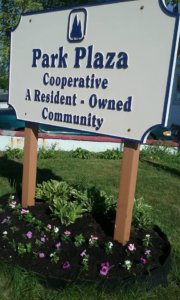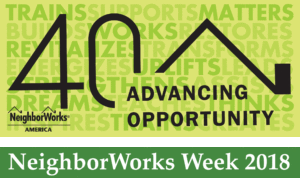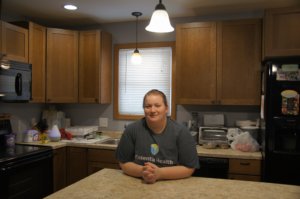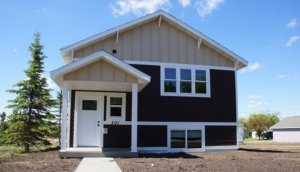In this interview with Prairie Business, Fagerstrom explains how the process works. The interview has been edited for clarity and length.
* * *
First, tell us about your organization.
The Northwest Minnesota Housing Cooperative is a for-profit construction company. We’re a co-op because we’re owned by local contractors, carpenters, plumbers, electricians and building-material suppliers; basically, anyone who works on a house is a member of our co-op.
Many of our 75 members are competitors in the free market. But since 1998, and in partnership with the Midwest Minnesota Community Development Corp. in Detroit Lakes, Minn., we’ve come together as a cooperative for special projects – those that involve building the lower-cost housing our communities need.
In recent years, as you know, first-time home buyers have had a very hard time finding single-family homes of any kind – let alone new homes — that they can afford.
Tell us about your experience with this issue.
In 1998, when the cooperative started, we were building single-family homes for $98,000.
That exact same house today costs $225,000.
So in 20 years, that’s what the market has done. It has more doubled the cost of the home.
Back in 1998, we were building for all kinds of first-time home buyers; that was our niche. We wanted to build for them and help them become permanent residents, and we used the financing and other tools provided by groups such as the MMCDC to make it happen..
And we were meeting that objective in 1998; but more recently, we haven’t met it. Instead, builders are putting up homes that cost $250,000 or more; and seemingly nothing could be done to bring down the price of a new home.
Tell us about the Greenwood Neighborhood Addition in Thief River Falls.
The basic concept is “smaller homes, smaller lots, smaller price tags.” So, instead of building a 1,500-square-foot rambler, we’re building a 930 square-foot split-entry home, on a 60-foot by 120-foot lot, with not a lot of fluff.
It’s kind of getting back to what the homes were like in the 1970s and ‘80s.
And in Phase 1 on Greenwood Avenue, we have 10 lots. We are down to just two open lots; the others have been sold, and the homes have been or are being built
For Phase 2, which will be located behind the Phase 1 homes, we have another 14 lots available. We have already requested the infrastructure for that, so that should be installed this summer.
Where did the idea come from?
The Greater Minnesota Housing Fund in St. Paul has a program called Building Better Neighborhoods, and for years, they’ve called for compact developments that can result in quality, affordable homes.
But we’ve always said that the market is not asking for it. The market doesn’t want it. Your homes are too small, your lots are too small. It doesn’t work.
We are rural Minnesota. We like our elbow room. We like our land. We don’t like our neighbors being right next to us.
So, we never felt that the market was ready for it. But after the housing readjustment here in 2008 to 2012, we decided it’s time.
Now, we are trying it, and so far we’ve been successful.
Tell us more about the houses.
Typically, these are buyers who are coming out of apartments and into their first home. So, to make our homes more affordable, we are really getting down to some bare basics, but without falling into “cheap.”
We still pitch to our buyers that we want them to own an investment. We want them to have the same American dream that everyone else has had; and that means we try to build houses that when people come in, they say, “Wow, this is awesome. I would love to live here.”
What kind of “bare basics” are involved?
The lot size is a big part of it. We are on 60- by 120-foot lots, so, there is not a lot of backyard, not a lot of grass space.
But again, we are selling to clients who are coming out of apartments. There, they don’t have any grass at all, so they’re usually thrilled just to get the house part of it.
The same with the garage. Again, our goal is to get the buyer into the house for the least amount of money. That means our base price includes just the house, with no garage.
If they can afford a garage in their mortgage, it could be added as an amenity in their purchase price. If they don’t have the cash right away, we’ll give them a gravel parking spot in the backyard on the site of what will be the garage
And when there is a garage, it’s in the rear. That’s important, and it’s because we’re dealing with narrow lots.
But it also adds to the appeal of the neighborhood, because as you drive by, you see houses, not garages.
What are some of the other cost-saving measures?
Here are some examples.
- For cabinetry in the kitchen, we’re using paneled cabinet straight doors, as opposed to a raised panel that might be solid oak construction.
Right there, that’s a savings of a couple of thousand dollars.
- The windows we are using are slider windows instead of casement windows. Yes, it changes the energy efficiency a little bit, but we compensate for that with other “green” features, such as the fact that all of the houses have spray-foamed insulation in the walls. So we upgrade the insulation side of it.
- The bedrooms are good-sized, but they’re not huge; and the carpet may not have super-lush padding underneath, if the buyer has selected a lower-cost option to keep themselves in budget.
- In the bedrooms, we have sliding bypass closet doors, which are the least expensive as opposed to bi-fold doors.
What’s the price of the home that results?
Basically, the starting point is about $160,000. Then if a buyer is going to finish the basement, they could add that for about another $20,000. That would add another bathroom, more bedrooms and another family room, in addition to the one upstairs.
Then if they had the funds available for a garage, they could add that for another $20,000.
Typically that includes a driveway and a sidewalk that would attach the garage to the house.
So with those two features, you’re sitting at about $200,000.
What do buyers think about having a detached garage in the back?
The ones we’ve talked to love the concept, because it’s all part of building a neighborhood, not just a development.
They like the old-fashioned feel of seeing houses – not garages – fronting the street.
Here’s a related amenity: We have a 10-foot bike path that goes all around this development, plus in the middle of it all, there’s going to be a city park. So that’s meaningful to the buyers: True, they’re not going to have a big yard, but they are going to have a neighborhood park just out their back door. So it works.
Are there other elements besides the smaller homes and smaller lot sizes that contribute to the homes’ affordability?
Absolutely. An equally important part is the financing side, and that has a number of components.
First, we partner with U.S. Department of Agriculture Rural Development. They offer housing loans, and some of those are set up to where our buyers have to come up with only $500 cash.
So, we can attract the working family that has a decent job, that knows they can support a monthly payment as they’re doing right now in their apartment, but that just doesn’t have a lot of cash sitting in their bank account to get into a brand new home.
USDA offers other programs, too, including one that lets them write interest rates down to as low as 1 percent. I’ve seen buyers who use that program have monthly payments of around $700, and that includes taxes and insurance.
But that’s an income-based program, so not everyone qualifies. Realistically, most buyers are getting in for monthly payments that are closer to $1,000, $1,200 or $1,500, depending on the amenities that they choose.
The USDA is federal. Are there local programs that also are available?
Yes. The other aspect that helps make the monthly payments affordable — and it’s an important piece — is community involvement.
For example, Thief River Falls offers $10,000 as an interest-free loan for 10 years. So if somebody wants to build a new home in town, the city will loan that buyer $10,000, and the buyer will pay that back, interest-free, over 10 years .
Another partnership that happened in this development was with the Minnesota Housing Finance Agency. They came in and said, OK, Thief River Falls, we see you need housing, and we’d like to help. So they offered $15,000 loans that are interest-free and payment-free for 30 years.
It’s still a loan, and the buyer still has to pay it back. But it’s $15,000 that the buyer can put toward the home now, but that won’t accrue interest or have to be paid down for 30 years.
The logic is that after that 30 years has expired, the buyer will have paid off his or her initial 30-year mortgage and can start making payments on the MHFA loan.
And of course, they do understand that most people won’t own their home for 30 years. So, if the buyers sell the house anytime in that 30 year period, they would then have to pay back that loan. They’d satisfy that loan just like they would any other on the house.
So it is a mortgage, but it’s also a generous offer.
Again, the point being to lower the buyers’ monthly payments?
Exactly. And I’ll give you one last example of that – and this is truly community participation.
As you know, a big part of the monthly payments in our area are the special assessments. Normally in a brand-new development, you have to build streets, curbs and gutters and install water and sewer, and all of that infrastructure costs money.
It can equate to special assessments of $200 a month on the buyer’s house payment.
Now, here’s what the city of Thief River Falls, Pennington County and the local School Board are doing to address that.
The buyers of these houses get a 6- to 9-year tax abatement, but it’s one that works in a unique way. Those buyers still pay their normal property taxes — nothing more, nothing less. But instead of that tax money going to the city, School Board and county, it actually goes to pay for the special assessments on the property.
Then once the owner’s special assessments are paid for, the abatement is lifted.
It’s a very Innovative way of letting the buyer have at their house payment lowered.
Why are those governing bodies offering that help?
Because they see the value of new housing.
They’re elected leaders, and they know that some local residents could get mad that these property taxes are not going into the general budget. But the truth is, if the taxing entities can get through the 6 to 9 years of the abatement, they will have created a home that’s going to be here for the next 100 years, generating taxes for this community.
Also, they look at these new houses, and they see how many of the young families in them are going to become permanent residents. As residents, they not only will be paying taxes. They’ll also be going to the local schools, paying utilities and using the local restaurants, grocery stores and all the retail and businesses downtown. They’ll also be the workforce that Digi-Key, Arctic Cat and other local employers need.
And last but not least, here’s the reality: We builders can’t do this by ourselves. The cost of new construction means that even the smaller and more affordable homes that we’re building still will cost buyers $160,000 to $200,000. That’s still a good chunk of change.
It has to be a partnership for this to work. And in this case, everyone is coming together and saying, “Let’s do this for our residents.”
 place to go in times of severe weather. In fact, Park Plaza homeowners have been dreaming of constructing a new storm shelter for almost a decade–ever since they came together to purchase their manufactured home community in 2011.
place to go in times of severe weather. In fact, Park Plaza homeowners have been dreaming of constructing a new storm shelter for almost a decade–ever since they came together to purchase their manufactured home community in 2011.




